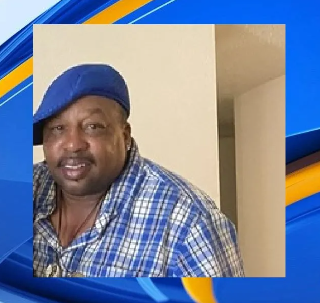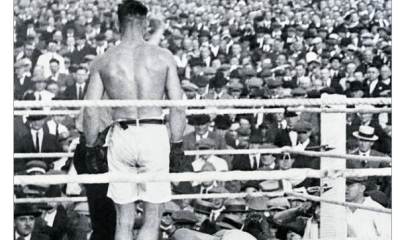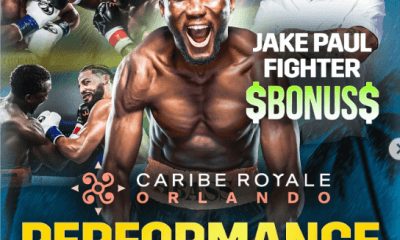Featured Articles
R.I.P. Eric Griffin, One of the Greatest Amateur Boxers of All Time

Eric Griffin passed away a week ago Saturday (Oct. 7) at age 55 at a hospital in Lafayette, Louisiana. Griffin was no great shakes as a pro, but the longtime resident of Broussard, Louisiana, was quite simply one of the greatest amateur boxers of all time.
That’s not one man’s opinion.
In 2000, a USA Boxing publication came out with a list of the top ten U.S. amateur boxers of the twentieth century. (USA Boxing, headquartered at the U.S. Olympic & Paralympic Training Center in Colorado Springs, Colorado, is the governing body of amateur boxing in the United States.)
All of the boxers on the list were former Olympians. No attempt was made to rank-order them. Listed alphabetically, here they are:
Mark Breland (1984, Los Angeles)
Cassius Clay (1960, Rome)
Oscar De La Hoya (1992, Barcelona)
Eddie Eagan (1920, Antwerp)
George Foreman (1968, Mexico City)
Joe Frazier (1964, Tokyo)
Eric Griffin (1992, Barcelona)
Roy Jones Jr. (1988, Seoul)
Sugar Ray Leonard (1976, Montreal)
Floyd Patterson (1952, Helsinki)
All but three of the boxers on this list are enshrined in the International Boxing Hall of Fame. The outsiders are Eddie Eagan, Breland, and Griffin. (FYI, Eddie Eagan never turned pro. The U.S. representative in the light heavyweight class at the 1920 Games in Belgium, he went on to earn a law degree from Yale, attended Oxford as a Rhodes Scholar, won a second gold medal at the 1932 Winter Games in Lake Placid, New York, as a member of the U.S. four-man bobsled team, and was the chairman of the New York State Athletic Commission from 1945 to 1951.)
All but two of the top-ten won Olympic titles. Eric Griffin’s name pops up again. Roy Jones Jr. is the other who returned home without a gold medal.
Eric Griffin, who grew to be five-foot-three, won his first amateur tournament at the age of 13. He weighed 80 pounds. In 1988, he suffered one of his rare losses when he was out-pointed by Michael Carbajal in the Olympic Trials. Regardless, Griffin was headed to the Olympic Summer Games in Seoul, Korea, either as the U.S. entrant in the light flyweight (106-pound) class or as an alternate in the event that Carbajal defeated him again in the Olympic Box Offs.
The Box Offs were held at Caesars Palace in Las Vegas. The Griffin-Carbajal rematch never materialized. On the eve of the match, Eric was sent home when the results of his drug test were made known. He had tested positive for marijuana, one of three boxers ousted from the Box Offs without throwing a punch. The others were Lavelle Finger and William Guthrie, both from St. Louis, who tested positive for cocaine.
Griffin protested his innocence but fessed up when his coach and sponsor Bob Jordan, an executive with a Houston company that manufactured computers, threatened to sue the UCLA lab that performed the test. Griffin wouldn’t let Jordan, a surrogate father to him – Eric never knew his biological father – go off on a wild goose chase.
Eric Griffin was then 20 years old. In addition to being kicked off the team, he was slapped with a six-month suspension. His next move, logically, was to turn pro, but he was more interested in repairing his image. Money would not wipe away the damage. So, he elected to stay the course in hopes of competing in the next Olympics, the 1992 games in Barcelona.
His relationship with Jordan was ruptured when he confessed to having smoked marijuana. As Sports Illustrated writer William Nack noted, Bob Jordan had grown up in a small town in the 1950s in a place and time where it was thought that anyone who tried marijuana was destined to become a dope fiend. Without Jordan’s financial assistance, Eric took a job washing dishes at a Houston restaurant to make ends meet. The two eventually reconciled and Griffin followed Jordan when Jordan returned to his hometown of Jasper, Tennessee, where Eric lived in a trailer with his wife and their young son.
During the years between the 1988 and 1992 Summer Games, Eric Griffin just kept winning and winning. He won four world titles and was twice a finalist for the Sullivan Award as the top amateur athlete in the United States. (No boxer has ever won this prestigious annual award which was first issued in 1930.)
Griffin not only made the 1992 U.S. Olympic boxing team but was named a co-captain along with Fort Worth bantamweight Sergio Reyes. The team’s head coach, Joe Byrd, said of Griffin, “he’s our heart, our backbone.”
Heading into Barcelona, the U.S. boxers accorded the best chance of winning a gold medal were Griffin and 19-year-old Los Angeles lightweight Oscar De La Hoya. Griffin was accorded far less ink in the U.S. press than De La Hoya who was more photogenic and had a better back story.
Barcelona 1992
This was the first Olympiad in which a computerized scoring system was used to determine the winner of each boxing match. The impetus was Roy Jones Jr, or rather the judges that ruled against Jones in the gold medal round four years earlier in Seoul, awarding the contest to his South Korean opponent. There have been controversial decisions in every Olympiad, but none aroused more indignation.
In Barcelona, there were five judges plus five alternates in the event of an electronic malfunction. Each of the judges had a metal box with two buttons, one for each fighter. When a punch landed, they pressed the appropriate button. For a punch to count on the master sheet, at least three judges had to hit the button within one second of each other. The boxer that landed the most punches was deemed the winner.
Griffin won his opening match comfortably. In his second bout, he was pit against a local man, Rafael Lozano, against whom he would be credited with landing 31 more punches. But not all of them registered on the official master sheet; only those that satisfied the one-second criterion. In round two, one of Griffin’s punches so buzzed Lozano that the referee issued a standing 8-count, but this punch did not register. At the end, the fight was awarded to the Spaniard by the ludicrous score of 6 to 5. “My stomach sank to the floor [when Lozano had his hand raised],” Griffin told a reporter at the press conference the next day, adding that it felt as if he had swallowed a bowling ball.
Griffin didn’t whine or curse the officials, but U.S. reporters were not so magnanimous. Griffin “traveled thousands of miles expecting to reconcile his sins, only to find that four years of sacrifice and commitment can be swept away in 9 minutes of incompetence,” fulminated George Diaz of the Orlando Sentinel. The judges, noted Bill Varner, a syndicated writer for the Gannett chain of papers, were all middle aged (the youngest was 42), but “were expected to have the reflexes needed to master children’s video games.”
Had Eric Griffin left Barcelona with a gold medal, he would have likely commanded a nice bonus from a major promotional group. But the sport’s heavy hitters – Bob Arum, Don King, and Dan Duva – had no interest in him; he was too small and too black. When he turned pro, it was with Philadelphia promoter Artie Pelullo who had a contract to promote a series of monthly shows at Las Vegas’ Riviera Hotel.
As a Pro
Fighting for Pelullo, Griffin won his first 11 fights. He lost the twelfth to Marcos Pacheco, a journeyman from Mexico, when he dislocated his left shoulder and was pulled out by his corner after six rounds. He avenged that setback in his next fight, winning a lopsided decision, and won three more fights before he suffered a loss that could not be explained away as a fluke. Against Carlos Murillo, a rough customer from Panama, both of Eric’s eyes were nearly shut when he was knocked down with a body punch in round nine and referee Steve Smoger waived it off.
Two more losses would follow, both to Jesus Chong, and they would write the finish to Eric Griffin’s boxing career. Chong stopped him in the seventh in their first encounter and in the second round of the sequel. The rematch at Caesars Palace in Las Vegas was for the WBO world light flyweight title vacated by Venezuela’s Leo Gamez who surrendered the belt when he could no longer make the weight.
Chong, from Durango, Mexico, packed a powerful punch – 28 of his 32 victories would come by knockout – but he was a wild swinger. Could it be that Eric Griffin, now only 29 years old and having answered the bell for only 102 rounds at the pro level, was already a shot fighter?
Yes. Davey Lee Armstrong, a two-time Olympian who fell victim to dementia before he died at age 64, was only 27 years old when his manager/trainer Emanuel Steward saw that his reflexes had dulled and urged him to retire. It wasn’t only that Armstrong had taken up boxing at a very young age, said Steward, but that as the best he was continually fighting the best and that compounded the wear and tear on his body.
After the Fall
When Eric left the sport, he returned to his hometown, Broussard, a city of about 10,000 situated a few miles down the road from Lafayette, the largest city and unofficial capital of Louisiana’s Cajun Country and worked on and off as a short order cook, the same occupation of his maternal grandmother, the woman that raised him. He had no conspicuous cognitive problems said his cousin Jason Papillion, with whom we spoke, but a clump of health issues that Papillion attributed to obesity. The picture of him that accompanied his obituary (the only useful picture that we could find for this story) is incongruent with that of a man who in his athletic heyday weighed less than 110 pounds.
In 1997, when Griffin was preparing for what would be his final fight, Michael Carbajal, his amateur rival, had already broken the glass ceiling for boxers in the smallest weight class, commanding a seven-figure purse for his first fight with Humberto “Chiquita” Gonzalez, and Oscar De La Hoya, Eric’s Olympic teammate, was already a multi-millionaire. Griffin’s last ring appearance was in a world title fight at Caesars Palace, home to some of the grandest boxing events of the era, but don’t be fooled. Griffin-Chong II wasn’t staged in the big outdoor arena under the stars, but in a ballroom. The fight wasn’t nationally televised; it aired exclusively on KCAL-TV in Los Angeles. The attendance, according to the Las Vegas Review-Journal, was 727, and Griffin’s purse, akin to that of Jesus Chong, was $20,000. That’s $20,000 gross before his manager and Uncle Sam got their cut.
Someone glancing at Griffin’s 16-4 pro record on boxrec, oblivious to his amateur exploits, would be surprised to find his name on a top-ten list with such legends as Cassius Clay/Muhammad Ali, George Foreman, Joe Frazier, and Sugar Ray Leonard. But boxing can be a cruel mistress and even some who achieved great heights in the squared circle have life stories that read as cautionary tales.
Griffin was laid to rest Saturday, Oct. 14. He is survived by, among others, two children, five grandchildren and Ms. Junel Thomas of Opelousas, Louisiana, his companion the last 10 years of his life. We here at TSS send our condolences.
Griffin’s cousin Jason Papillion keeps the flame of boxing alive in Cajun Country. If you are ever down in that neck of the woods, drop by Papillion’s Boxing Club in Lafayette and tell him we said “hi.” Papillion had a solid, if unspectacular, pro boxing career of his own, competing against such notables as Winky Wright, and Jason’s son Keon Papillion is a promising super welterweight prospect with a 6-0-1 record.
We asked Papillion what he would remember about Eric Griffin the man. “He was full of love and got a lot of love in return,” he said. “He was a very humble guy who never forgot where he came from.”
In the grand scheme of things, perhaps that counts for more than an Olympic gold medal.
—
Arne K. Lang is a recognized authority on the history of prizefighting and the history of American sports gambling. His latest book, titled Clash of the Little Giants: George Dixon, Terry McGovern, and the Culture of Boxing in America, 1890-1910, was released by McFarland in September, 2022.
To comment on this story in the Fight Forum CLICK HERE
-

 Featured Articles4 weeks ago
Featured Articles4 weeks agoThe Hauser Report: Cinematic and Literary Notes
-

 Book Review3 weeks ago
Book Review3 weeks agoMark Kriegel’s New Book About Mike Tyson is a Must-Read
-

 Featured Articles2 weeks ago
Featured Articles2 weeks agoThe Hauser Report: Debunking Two Myths and Other Notes
-

 Featured Articles3 weeks ago
Featured Articles3 weeks agoMoses Itauma Continues his Rapid Rise; Steamrolls Dillian Whyte in Riyadh
-

 Featured Articles4 weeks ago
Featured Articles4 weeks agoKotari and Urakawa – Two Fatalities on the Same Card in Japan: Boxing’s Darkest Day
-

 Featured Articles2 weeks ago
Featured Articles2 weeks agoNikita Tszyu and Australia’s Short-Lived Boxing Renaissance
-

 Featured Articles2 weeks ago
Featured Articles2 weeks agoIs Moses Itauma the Next Mike Tyson?
-

 Featured Articles4 weeks ago
Featured Articles4 weeks agoRamirez and Cuello Score KOs in Libya; Fonseca Upsets Oumiha



















